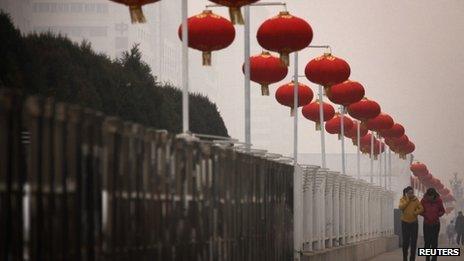Smog levels spike as Beijing ushers in Chinese New Year
- Published

Pollution soared amid celebrations but fell again as revellers went to bed
Fireworks unleashed sound and colour across China at the start of the Lunar New Year, but also something else - pollution.
A new monitoring index revealed a dramatic increase in fine particles in the air in the first hours of the Year of the Dragon.
The figures tailed off only after 0600, when revellers presumably went to bed.
The data comes from an index that Beijing city government began publishing only on Saturday.
The PM2.5 index measures air particles that are less than 2.5 micrometres in size.
Up until a few days ago the city authorities were only releasing information using the PM10 index, which measures slightly larger particles.
The US embassy in Beijing has been collecting and publishing PM2.5 information for some time. Its numbers often suggest the city's air is more polluted than the local government figures show.
'Hazardous'
Beijing's new PM2.5 data is published on the website of the Beijing Environmental Monitoring Centre.
It recorded the figure of 1.593mg/m3 at 0100 on Monday, as the city's residents welcomed the arrival of the new year by setting off millions of fireworks.
This PM2.5 number is more than three times the level the US embassy says is "hazardous".
By 0700, though, Beijing's PM2.5 level had dropped to 0.04, which the US embassy describes as "good".
Beijing city authorities have been collecting PM2.5 information for five years - but announced they would release the figures only a few weeks ago.
Local officials appeared to make the decision to publish the stricter pollution standard because of a growing environmental awareness in the city.
Many residents have been following the US embassy's index for some time.
At the moment, Beijing only publishes PM2.5 data from one "research" monitoring station, but it plans to extend the service.
The city's air quality usually improves over Chinese New Year, as factories close down and people stay at home and out of their cars.
- Published21 January 2012
- Published7 December 2011
- Published6 December 2011